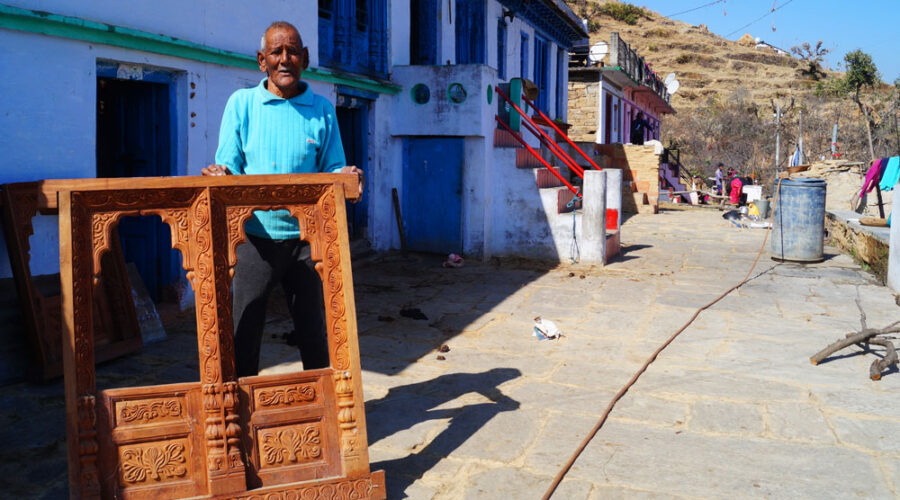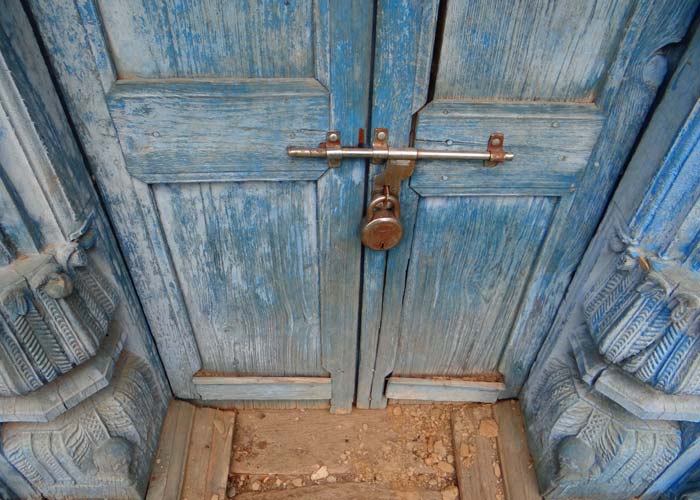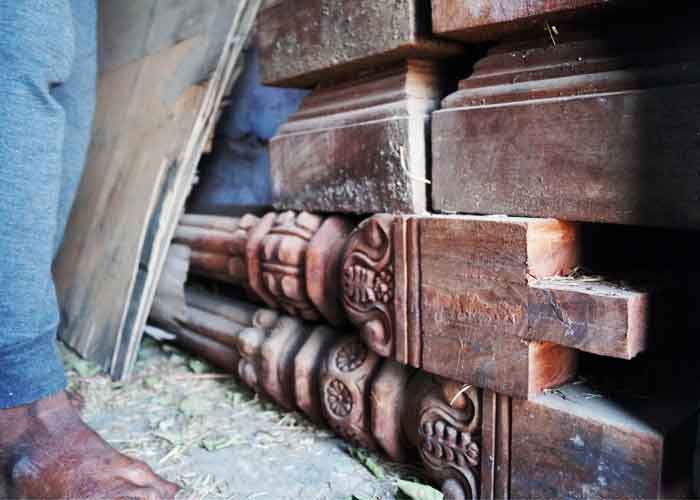When I was young, I was so passionate about Likhai that I would start working early in the morning and continue till the evening without taking a break. But now my eyesight is weak and my fingers don’t have enough strength.
~ Ganga Ram Ji

We parked our car and climbed up the hill puffing and panting. The road has arrived for easy connectivity, but it still takes a good climb to reach Diyari village. We are here to meet Ganga Ram Ji. There were no house addresses to look for, but everyone in the village knows that he lives right at the hilltop.
“I will get you some tea”, said Ganga Ram Ji’s wife Sita Devi Ji. The best thing about us Indians is the ingrained hospitality. We don’t let anyone visit our house and leave without serving water, tea, and some food. We sat under the pleasant sun in the stone-paved courtyard. The locals refer to these stone slabs as ‘Pataal’ (पटाल) and use them to pave courtyards and make roofs of traditional houses. The vernacular houses, locally known as ‘Bakhli’ (बाखली) in Kumaon are set in a long line with many families, often blood relatives, living together.
Gangaram Ji opens the wooden door of an animal shelter (‘Goth’ – गोठ) which they use to store Likhai artifacts. Each window pane and pillar weighs a ton and three of us had to lift them out in the sun. But Ganga Ram Ji says he could move such a windowpane by himself when he was young and still taking classes in ‘Likhai’ (लखाई) from Nariram Ji, his teacher who would visit Diyari to teach the students back in the 1940s.
While Almora was the main center of Likhai craft, we can see it in numerous villages as we do a tour of Uttarakhand, especially in the Pithoragarh district of Kumaon hills. If there is no inspiration to carry on the tradition, we fail to see the value in our own heritage. Consequently, people started building their houses with concrete with simple windowpanes chopped and finished in a mill. However, storytelling on Likhai craft is a small but effective way to bring back the lost pride for this craft form.
May we mention that it was the time of the year when apples were blooming in Kumaon.
You don’t find the tools for Likhai in a market. Every artisan would make his own tools and gain perfection over time. No two sets of tools would ever be the same. As it is rightly said, we cannot skip the time required to gain knowledge of a subject or master an art form. One needs to go through the grind.
There are no standard design patterns in Likhai. It depends on what inspires the artist. Back in the days of yore, elements of nature such as birds, ferns, pine cones, creepers, lotus flower, and Hindu gods and goddesses were the sources of inspiration. Likhai is confined only to the temples in Garhwal. But in Kumaon you can see it in common houses most of which are painted white.
There are many folk tales about the reason why most traditional houses were painted white. One of them relates to the simple psychology of color which relates white to peace and purity which one would want in their family. The Likhai doors and windows were mostly painted in blue, green, light brown. One can also see the occasional use of bright red and multicolor designs.
I come from a community of Likhai craftsmen. We did this for our homes, our communities, and to barter for food grain. Likhai is our tradition (‘प्रथा’).
~ Ganga Ram Ji


There have been many reasons for Likhai craft to dwindle over time. One of the reasons is the availability of wood. The craftsmen preferred walnut or red cedar (‘toon’ – तून) for Likhai since it is dense and has a suitable grain pattern. But these trees take time to grow, unlike the pine trees which grow fast and adversely affect the Himalayan ecosystem including the quality of the soil, other native plant species, and water level.
Pine trees were introduced for commercial logging and extraction of the resin used in the paint industry. Before independence, the use of Himalayan timber resources was kept limited to the British, and post-independence policies weren’t helpful. The youth wasn’t interested in Likhai craft either, but we can call it the process of natural evolution. All these factors led to the gradual decline of this craft form.
Gangaram Ji completed his life’s journey peacefully in 2018. But storytelling through sustainable tourism is one of the ways to strongly keep the oral tradition alive, especially when it is done by the community itself.
—
A beautiful story and sad that the old crafts are dwindling. I particularly liked the way his death was put in terms of completing his life’s journey.
Thank you for taking the time to read the story, Ann 🙂 Locals are taking small but promising initiatives in Uttarakhand to restore the damaged Likhai work from old homes and to make new ones. There is a long way to go.
Thanks for bringing into the lime light about Likhai Craft and Craftmenship which is Unique in its own way.
Sharing with an article on Andhra Pradesh Toys who got visibility after geo tagged which can be done for the Likhai Craft too.
https://www.indiatoday.in/education-today/gk-current-affairs/story/etikoppaka-toys-gi-tagging-1075645-2017-11-04
Thank you for sharing the article on Etikoppaka toys. It is very interesting.
Are there still any artisans who practice Likhai now or any alternative way to learn the craft?
Yes, there are but very few. Ganga Ram ji’s son has taken up this art as a livelihood. However, the quality of the art keeps dropping a notch lower with each generation. Nevertheless, he is doing great work and some local hotels and homes are buying from him.